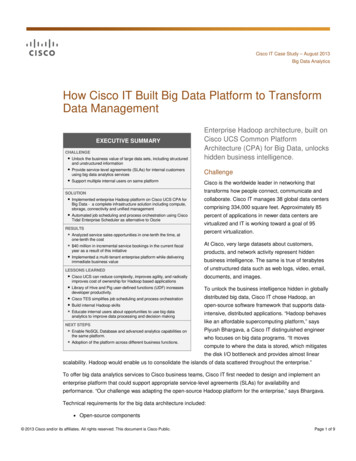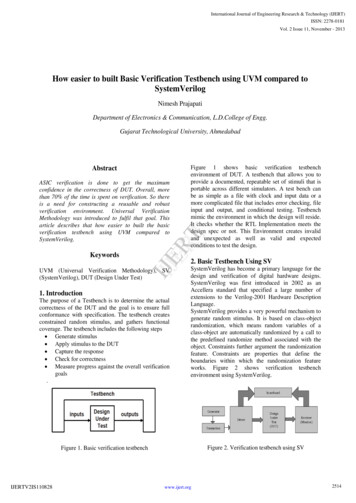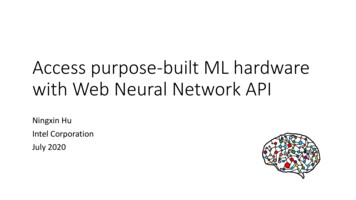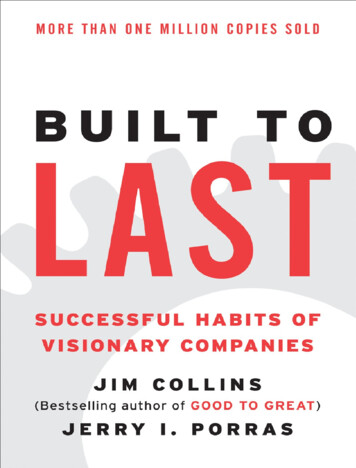
Transcription
Cisco IT Case Study – August 2013Big Data AnalyticsHow Cisco IT Built Big Data Platform to TransformData ManagementEXECUTIVE SUMMARYCHALLENGE Unlock the business value of large data sets, including structuredand unstructured information Provide service-level agreements (SLAs) for internal customersusing big data analytics services Support multiple internal users on same platformSOLUTION Implemented enterprise Hadoop platform on Cisco UCS CPA forBig Data - a complete infrastructure solution including compute,storage, connectivity and unified management Automated job scheduling and process orchestration using CiscoTidal Enterprise Scheduler as alternative to OozieRESULTS Analyzed service sales opportunities in one-tenth the time, atone-tenth the cost 40 million in incremental service bookings in the current fiscalyear as a result of this initiative Implemented a multi-tenant enterprise platform while deliveringimmediate business valueLESSONS LEARNED Cisco UCS can reduce complexity, improves agility, and radicallyimproves cost of ownership for Hadoop based applications Library of Hive and Pig user-defined functions (UDF) increasesdeveloper productivity. Cisco TES simplifies job scheduling and process orchestration Build internal Hadoop skills Educate internal users about opportunities to use big dataanalytics to improve data processing and decision makingNEXT STEPS Enable NoSQL Database and advanced analytics capabilities onthe same platform. Adoption of the platform across different business functions.Enterprise Hadoop architecture, built onCisco UCS Common PlatformArchitecture (CPA) for Big Data, unlockshidden business intelligence.ChallengeCisco is the worldwide leader in networking thattransforms how people connect, communicate andcollaborate. Cisco IT manages 38 global data centerscomprising 334,000 square feet. Approximately 85percent of applications in newer data centers arevirtualized and IT is working toward a goal of 95percent virtualization.At Cisco, very large datasets about customers,products, and network activity represent hiddenbusiness intelligence. The same is true of terabytesof unstructured data such as web logs, video, email,documents, and images.To unlock the business intelligence hidden in globallydistributed big data, Cisco IT chose Hadoop, anopen-source software framework that supports dataintensive, distributed applications. “Hadoop behaveslike an affordable supercomputing platform,” saysPiyush Bhargava, a Cisco IT distinguished engineerwho focuses on big data programs. “It movescompute to where the data is stored, which mitigatesthe disk I/O bottleneck and provides almost linearscalability. Hadoop would enable us to consolidate the islands of data scattered throughout the enterprise.”To offer big data analytics services to Cisco business teams, Cisco IT first needed to design and implement anenterprise platform that could support appropriate service-level agreements (SLAs) for availability andperformance. “Our challenge was adapting the open-source Hadoop platform for the enterprise,” says Bhargava.Technical requirements for the big data architecture included: Open-source components 2013 Cisco and/or its affiliates. All rights reserved. This document is Cisco Public.Page 1 of 9
Scalability and enterprise-class availability Multitenant support so that multiple Cisco teams could use the same platform at the same time Overcoming disk I/O speed limitations to accelerate performance Integration with IT support processesSolutionCisco IT Hadoop platform is build using Cisco UCS Common Platform Architecture (CPA) for Big Data. Highlevel architecture of the solution is shown in Figure 1.Figure 1.Cisco IT Hadoop PlatformCisco UCS 6248UPFabric Interconnects( Per Domain )ScalabilityCisco Nexus2232PP 10 GEFabric Extenders( Per Rack)High PerformanceHigh AvailabilityZooKeeper andWebServerZooKeeper andWebServerZooKeeper ckerOperationalSimplicityUnifiedManagementThree nodes apiece for ZooKeeper, CLDB, WebServer, and JobTrackerFile Server and TaskTracker Run Across All NodesCisco IT Hadoop Platform is designed to provide high performance in a multitenant environment, anticipating thatinternal users will continually find more use cases for big data analytics. “Cisco UCS CPA for Big Data providesthe capabilities we need to use big data analytics for business advantage, including high-performance, scalability,and ease of management,” says Jag Kahlon, Cisco IT architect.Linearly Scalable Hardware with Very Large Onboard Storage CapacityThe compute building block of the Cisco IT Hadoop Platform is the Cisco UCS C240 M3 Rack Servers, 2-RUserver power by two Intel Xeon E5-2600 series processors, 256 GB of RAM, and 24 TB of local storage. Out of the24 TB, Hadoop Distributed File System (HDFS) can use 22 TB, and the remaining 2 TB is available for theoperating system.“Cisco UCS C-Series Servers provide high performance access to local storage, the biggest factor in Hadoop 2013 Cisco and/or its affiliates. All rights reserved. This document is Cisco Public.Page 2 of 9
performance” says Virendra Singh, Cisco IT architect.“Cisco UCS C-Series Servers provide high performance access tolocal storage, the biggest factor in Hadoop performance”Virendra Singh, Cisco IT ArchitectThe current architecture comprises of four racks, each containing 16 server nodes supporting 384 TB of rawstorage per rack. “This configuration can scale to 160 servers in a single management domain supporting 3.8petabytes of raw storage capacity,” says Kahlon.Low-Latency, Lossless Network ConnectivityCisco UCS 6200 Series Fabric Interconnects provides high speed, low latency connectivity for servers andcentralized management for all connected devices with UCS Manager. Deployed in redundant pairs offers the fullredundancy, performance (active-active), and exceptional scalability for large number of nodes typical in big dataclusters.Each rack connects to the fabric interconnects through a redundant pair of Cisco Nexus 2232PP FabricExtenders, which behave like remote line cards.Simple ManagementCisco IT server administrators manage all elements of the Cisco UCS including servers, storage access,networking, and virtualization from a single Cisco UCS Manager interface. “Cisco UCS Manager significantlysimplifies management of our Hadoop platform” says Kahlon. “UCS Manager will help us manage larger clustersas our platform grows without increasing staffing.” Using Cisco UCS Manager service profiles saved time andeffort for server administrators by making it unnecessary to manually configure each server. Service profiles alsoeliminated configuration errors that could cause downtime.“Cisco UCS Manager significantly simplifies management of ourHadoop platform. UCS Manager will help us manage larger clusters asour platform grows without increasing staffing”Jag Kahlon, Cisco IT ArchitectOpen, Enterprise-Class Hadoop DistributionCisco IT uses MapR Distribution for Apache Hadoop, which speeds up MapReduce jobs with an optimized shufflealgorithm, direct access to the disk, built-in compression, and code written in advanced C rather than Java.“Hadoop complements rather than replaces Cisco IT’s traditional data processing tools, such as Oracle andTeradata,” Singh says. “Its unique value is to process unstructured data and very large data sets far more quicklyand at far less cost.” 2013 Cisco and/or its affiliates. All rights reserved. This document is Cisco Public.Page 3 of 9
Hadoop Distributed File System (HDFS) aggregates the storage on all Cisco UCS C240 M3 servers in the clusterto create one large logical unit. Then, it splits data into smaller chunks to accelerate processing by eliminatingtime-consuming extract, transform, and load (ETL) operations. “Processing can continue even if a node failsbecause Hadoop makes multiple copies of every data element, distributing them across several servers in thecluster,” says Hari Shankar, Cisco IT architect. “Even if a node fails, there is no data loss.” Hadoop senses thenode failure and automatically creates another copy of the data, distributing it across the remaining servers. Totaldata volume is no larger than it would be without replication because HDFS automatically compresses the data.Cisco Tidal Enterprise Scheduler (TES)For job scheduling and process orchestration, Cisco IT uses Cisco TES as a friendlier alternative to Oozie, thenative Hadoop scheduler. Built-in Cisco TES connectors to Hadoop components eliminate manual steps such aswriting Sqoop code to download data to HDFS and executing a command to load data to Hive. “Using Cisco TESfor job scheduling saves hours on each job compared to Oozie because reducing the number of programmingsteps means less time needed for debugging,” says Singh.Another advantage of Cisco TES is that it operates on mobile devices, enabling Cisco end users to execute andmanage big data jobs from anywhere.“Using Cisco TES for job scheduling saves hours on each jobcompared to Oozie because reducing the number of programmingsteps means less time needed for debugging.”Virendra Singh, Cisco IT ArchitectLooking Inside a Cisco IT Hadoop JobThe first big data analytics program in production at Cisco helps to increase revenues by identifying hiddenopportunities for partners to sell services. “Previously, we used traditional data warehousing techniques to analyzethe install base that identified opportunities for the next four quarters,” says Srini Nagapuri, Cisco IT projectmanager. “But analysis took 50 hours, so we could only generate reports once a week.” The other limitation of theold architecture was the lack of a single source of truth for opportunity data. Instead, service opportunityinformation was spread out across multiple data stores, causing confusion for partners and the Cisco partnersupport organization.The new big data analytics solution harnesses the power of Hadoop on the Cisco UCS CPA for Big Data toprocess 25 percent more data in 10 percent of the time. The data foundation includes the following: Cisco Technical Services contracts that will be ready for renewal or will expire within five calendar quarters Opportunities to activate, upgrade, or upsell software subscriptions within five quarters Business rules and a management interface to identify new types of opportunity data Partner performance measurements, expressed as the opportunity-to-bookings conversion ratioFigure 2 and Table 1 show the physical architecture, and Figure 3 shows the logical architecture. 2013 Cisco and/or its affiliates. All rights reserved. This document is Cisco Public.Page 4 of 9
Figure 2.Physical Architecture for Hadoop Platform to Identify Partner Sales OpportunitiesSoftware Components in Cisco IT’s Big Data Analytics PlatformComponentFunctionMapReduceDistributed computing framework. Data is processed on the same Cisco UCS server where it resides,avoiding latency while data is accessed over the network.HiveSQL-like interface to support analysis of large data sets and data summarization.Cisco Tidal EnterpriseScheduler (TES)Workload automation, job scheduling, event management and process orchestration.PigData flow language. Enables Cisco IT to process big data without writing MapReduce programs.HBaseColumnar database built on top of HDFS for low-latency read and write operations.SqoopTool to import and export data between traditional databases and HDFS.FlumeTool to capture and load log data to HDFS in real time.ZooKeeperCoordination of distributed processes to provide high availability. 2013 Cisco and/or its affiliates. All rights reserved. This document is Cisco Public.Page 5 of 9
Figure 3.Cisco Hadoop Logical ArchitectureClientJob Status traReplicationGenericUsercking(Read OnAdminly)PerformanMySQL ServerHiveMetastore Metrics DB ce MetricsLoad BalancedJob SubmissionCisco TESJob OrchestrationJob SchedulerFlume,sqoopRDBMSOLTP/DSS/DWHadoop ClusterCLDBZooKeeperMapR-FS,Task/Job TrackerWebServerTools (Server Comp)ResultsCisco IT has introduced multiple big data analytics programs, all of them operating on the Cisco UCS CommonPlatform Architecture (CPA) for Big Data.Increased Revenues from Partner SalesThe Cisco Partner Annuity Initiative program is in production. The enterprise Hadoop platform acceleratedprocessing time for identifying partner services sales opportunities from 50 hours to 6 hours, and identifiesopportunities for the next five calendar quarters instead of four quarters. It also lets partners and Cisco employeesdynamically change the criteria for identifying opportunities. “With our Hadoop architecture, analysis of partnersales opportunities completes in approximately one-tenth the time it did on our traditional data analysisarchitecture, and at one-tenth the cost,” says Bhargava.“With our Hadoop architecture, analysis of partner sales opportunitiescompletes in approximately one-tenth the time it did on our traditionaldata analysis architecture, and at one-tenth the cost.”Piyush Bhargava, Cisco IT Distinguished EngineerBusiness benefits of the Cisco Partner Annuity Initiative include: Generating an anticipated US 40 million incremental revenue from partners in FY13: “The solutionprocesses 1.5 billion records daily, and we identified new service opportunities the same day we placed 2013 Cisco and/or its affiliates. All rights reserved. This document is Cisco Public.Page 6 of 9
the system in production,” says Nagapuri. Cisco is on track to reach the revenue goal. Improving the experience for Cisco partners, customers, and employees: Consolidating to a single sourceof truth helps to avoid the confusion on available service opportunities. Creating the foundation for other big data analytics projects: Moving the customer install base andservice contracts to the Hadoop platform will provide more value in the future because other Ciscobusiness teams can use it for their own initiatives.Increased Productivity by Making Intellectual Capital Easier to FindMany of the 68,000 employees at Cisco are knowledge workers who tend to search for content on companywebsites throughout the day. But most of the content is not tagged with all relevant keywords, which makessearches take longer. “People relate to content in more ways than the original classification,” says Singh. Inaddition, employees might not realize content already exists, leading them to invest time and money recreatingcontent that is already available.To make intellectual capital easier to find, Cisco IT is replacing static, manual tagging with dynamic tagging basedon user feedback. The program uses machine-learning techniques to examine usage patterns and also acts onuser suggestions for new tags.The content auto-tagging program is currently in proof-of-concept, and Cisco IT is creating a Cisco SmartBusiness Architecture (SBA) for other companies.Measured Adoption of Collaboration Applications and Assessed Business ValueOrganizations that make significant investments in collaboration technology generally want to measure adoptionand assess business value. The Organization Network Analytics program is currently a proof-of-concept. Its goalis to measure collaboration within the Cisco enterprise, develop a benchmark, and present the information on anintuitive executive dashboard (Figure 4). “Our idea is to identify deviations from best practices and to measureeffectiveness of change management,” Singh says.Figure 4.Collaboration Benchmark Usage Analysis – Sample Report6543Org. X1Benchmark0Best practiceEmailPh (10on 0s)e(10IM s)Au (1So di 0sci o C )alSo onf.fW twaD e b reeCIm skto onfm per Vi .sidve eoVideo2 2013 Cisco and/or its affiliates. All rights reserved. This document is Cisco Public.Page 7 of 9
The Hadoop platform analyzes logs from collaboration tools such as Cisco Unified Communications, email, CiscoTelePresence , Cisco WebEx , Cisco WebEx Social, and Cisco Jabber to reveal preferred communicationsmethods and organizational dynamics. When business users studying collaboration enter analysis criteria, theprogram creates an interactive visualization of the social network.Next StepsCisco IT continues to introduce different big data analytics programs and add more types of analytics. Plansinclude: Identifying root causes of technical issues: The knowledge that support engineers acquire can remainhidden in case notes. “We expect that mining case notes for root causes will unlock the value of thisunstructured data, accelerating time to resolution for other customers,” says Nagapuri The sameinformation can contribute to better upstream systems, processes, and products. Analyzing service requests, an untapped source of business intelligence about product usage, reliability,and customer sentiment: “A deeper understanding of product usage will help Cisco engineers optimizeproducts,” Singh says. The plan is to mash up data from service requests with quality data and servicedata. The underlying big data analytics techniques include text analytics, entity extraction, correlation,sentiment analysis, alerting, and machine learning. Supporting use cases where NoSQL provides improved performance or scalability compared to traditionalrelational databases. Scaling the architecture by adding another 60 nodes: Cisco IT is deciding whether to add the nodes to thesame Cisco UCS cluster or build another cluster that connects to the first using Cisco Nexus switches.Lesson LearnedCisco IT shares the following observations with other organizations that are planning big data analytics programs.Technology Hive is best suited for structured data processing, but has limited SQL support. Sqoop scales well for large data loads. Network File System (NFS) saves time and effort for data loads. Cisco TES simplifies job scheduling, process orchestration and accelerates debugging. Creating a library of user-defined functions (UDF) for Hive and Pig helps to increase developer productivity. Once internal users realize that IT can offer big data analytics, demand tends to grow very quickly. Using Cisco UCS Common Platform Architecture (CPA) for Big Data, Cisco IT built a scalable Hadoopplatform that can support up to 160 servers in a single switching domain.Organization Build internal Hadoop skills. “People keep identifying new use cases for big data analytics, and buildinginternal skills to implement the use cases will help us keep up with demand,” says Singh. Educate internal users that they can now analyze unstructured data (email, webpages, documents, and soon) in addition to databases. 2013 Cisco and/or its affiliates. All rights reserved. This document is Cisco Public.Page 8 of 9
For More InformationCisco IT case studies on a variety of business solutions, visit Cisco on Cisco: Inside Cisco IT www.cisco.com/go/ciscoitCisco UCS CPA for Big Data: blogs.cisco.com/datacenter/cpa/ 340/ns517/ns224/ns944/wp greenplum.pdf www.cisco.com/go/bigdataCisco Tidal Enterprise Scheduler: www.cisco.com/go/workloadautomationNoteThis publication describes how Cisco has benefited from the deployment of its own products. Many factors mayhave contributed to the results and benefits described; Cisco does not guarantee comparable results elsewhere.CISCO PROVIDES THIS PUBLICATION AS IS WITHOUT WARRANTY OF ANY KIND, EITHER EXPRESS ORIMPLIED, INCLUDING THE IMPLIED WARRANTIES OF MERCHANTABILITY OR FITNESS FOR APARTICULAR PURPOSE.Some jurisdictions do not allow disclaimer of express or implied warranties, therefore this disclaimer may not applyto you. 2013 Cisco and/or its affiliates. All rights reserved. This document is Cisco Public.Page 9 of 9
Cisco Tidal Enterprise Scheduler (TES) For job scheduling and process orchestration, Cisco IT uses Cisco TES as a friendlier alternative to Oozie, the native Hadoop scheduler. Built-in Cisco TES connectors to Hadoop components eliminate manual steps such as writing Sqoop code to download d











